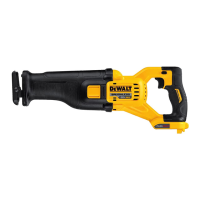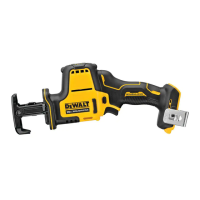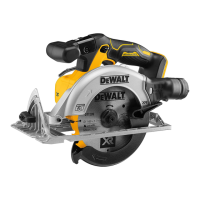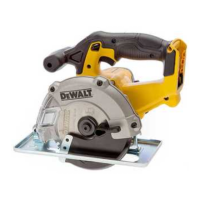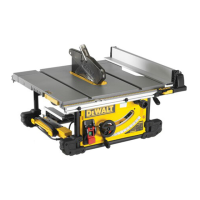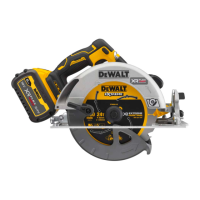36
ENGLISH
Tool Tag Ready (Fig. E)
Optional Accessory
Your cut-off tool comes with mounting holes
22
and fasteners
for installing a
Tool Tag. You will need a T15 bit tip to
install the tag. The
Tool Tag is designed for tracking and
locating professional power tools, equipment, and machines
using the
Tool Connect™ app. For proper installation of
the
Tool Tag refer to the
Tool Tagmanual.
OPERATION
Instructions for Use
WARNING: Always observe the safety instructions and
applicableregulations.
WARNING: To reduce the risk of serious personal
injury, turn tool off and disconnect battery pack
before making any adjustments or removing/
installing attachments or accessories. Make sure the
trigger switch is in the OFFposition. An accidental start-up
can causeinjury.
Proper Hand Position (Fig. F)
WARNING: To reduce the risk of serious personal injury,
ALWAYS use proper hand position asshown.
WARNING: To reduce the risk of serious personal
injury, ALWAYS hold securely in anticipation of a
suddenreaction.
Proper hand position requires one hand on the main handle
1
and one hand on the front handle
7
.
Spindle Lock Button (Fig. A, C)
The spindle lock button
10
is used to lock the spindle
21
when
changing accessories.
1. To engage the spindle lock button, remove the battery pack
and make sure trigger switch is in OFFposition.
2. Depress the spindle lock button and turn the wheel and
spindle until the lock button engages the spindle.
3. Use supplied wrench
5
to unscrew the spindle nut
17
and remove or mount accessories. Spindle threads are
righthand.
Lock-Off Button (Fig. A)
Your cut-off tool is equipped with a lock-off button
3
. To lock
the trigger switch in the OFF postition, push the lock-off button
from the left side of the tool. To unlock the trigger switch, push
the lock-off button from the right side of thetool.
LED Light (Fig. A)
The LED light
6
will illuminate as a warning when the tool is
being pushed too hard. Continuing to use the tool after the LED
is lit could cause the tool to hot pack or shutdown.
To Operate (Fig. A)
CAUTION: Before attempting to start, grasp tool firmly
with both hands beforelifting.
WARNING: Edge cutting can be performed only with
wheels that are designed and specified for this purpose.
Protect yourself during edge cutting by directing the open
side of the guard toward asurface.
WARNING: Wheels used for cutting may break or kick
back if they bend or twist while the tool is being used to do
cut-offwork.
WARNING: Do not use edge cutting wheels for surface
grinding applications because these wheels are not
designed for side pressures encountered with surface
grinding. Wheel breakage and injury mayresult.
1. Grasp main handle
1
and front handle
7
firmly.
2. Line up wheel with material to be cut. Be sure nothing is
near or in line with thewheel.
3. Depress and hold trigger switch
2
then slowly feed wheel
into work with firm pressure. The shoe
12
may be used
to help guide the tool when making cuts. Do not force the
tool. For maximum efficiency and wheel life, keep the wheel
speedhigh.
4. To stop tool, release trigger switch
2
.
Wet Cut Method (Fig. A, G, H)
CAUTION: Never use the saw over head. When using
water, limit cutting to the horizontal position to reduce the
risk of water entering thetool.
WARNING: Wet cut method is to be used only with a
diamondblade.
1. Attach the water supply to the water inlet
15
.
2. To regulate the water flow, rotate the water valve
13
to
the open position as shown in FigureG. To stop the flow of
water, rotate the water valve to the closedpostion as shown
in FigureH.
3. Proceed to cut as described in ToOperate.
4. After work, disconnect the water supply from thetool.
Applications
WARNING: NEVER cut magnesium with this tool.
Magnesium particles may ignite causing personalinjury.
WARNING: Cutting concrete must ONLY be done using
the wet cutmethod.
• 3mm max. gauge sheet metal
• Concrete, cinder blocks and bricks
• Reinforcing rod; generally under 25.4mm diameter
• 3mm diameter concrete wire mesh
• Corrugated floor and ceiling form (concrete forms)
• Electrical conduit 3mm wall thickness
• 3mm max. thick structural forms such as channel, angles,
plate,etc.
NOTE: The cutting of materials heavier than those listed
above are not recommended due to the possibility of
electricaloverloading.
